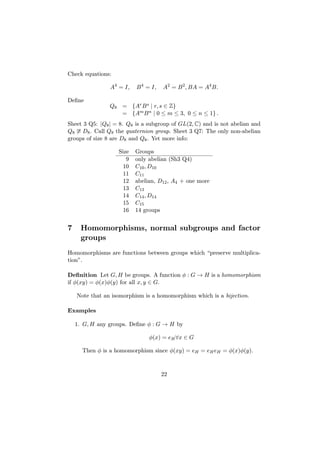The document provides notes on group theory. It discusses the definition of groups and examples of groups such as (Z, +), (Q, ×), and Sn. Properties of groups like Lagrange's theorem and criteria for subgroups are also covered. The notes then discuss symmetry groups, defining isometries of R2 and showing that the set of isometries forms a group. Symmetry groups G(Π) of objects Π in R2 are introduced and shown to be subgroups. Specific examples of symmetry groups like those of triangles, squares, regular n-gons, and infinite strips are analyzed. Finally, the concept of group isomorphism is defined and examples are given to illustrate isomorphic groups.
![M2PM2 Notes on Group Theory
Here are some notes on the M2PM2 lectures on group theory.
1 Revision from M1P2
Would be a good idea to refresh your memory on the following topics from
group theory.
(a) Group axioms: closure, associativity, identity, inverses
(b) Examples of groups:
(Z, +), (Q, +), (Q∗, ×), (C∗, ×), etc
GL(n, R), the group of all invertible n×n matrices over R, under matrix
multiplication
Sn, the symmetric group, the set of all permutations of {1, 2, . . . , n},
under composition. Recall the cycle notation for permutations – every per-
mutation can be expressed as a product of disjoint cycles.
For p prime Z∗
p = {[1], [2], . . . , [p − 1]} is a group under multiplication
modulo p.
Cn = {x ∈ C : xn = 1} = {1, ω, ω2, . . . , ωn−1} is a cyclic group of size n,
where ω = e2πi/n.
(c) Some theory:
Criterion for subgroups: H is a subgroup of G iff (1) e ∈ H; (2) x, y ∈
H ⇒ xy ∈ H, and (3) x ∈ H ⇒ x−1 ∈ H.
For a ∈ G, we define the cyclic subgroup a = {an : n ∈ Z}. The size
of a is equal to o(a), the order of a, which is defined to be the smallest
positive integer k such that ak = e.
Lagrange: if H is a subgroup of a finite group G then |H| divides |G|.
Consequences: (1) For any element a ∈ G, o(a) divides |G|.
(2) If |G| = n then xn = e for all x ∈ G
(3) If |G| is prime then G is a cyclic group.
1](https://image.slidesharecdn.com/grouptheorynotes-170210160717/85/Group-theory-notes-1-320.jpg)
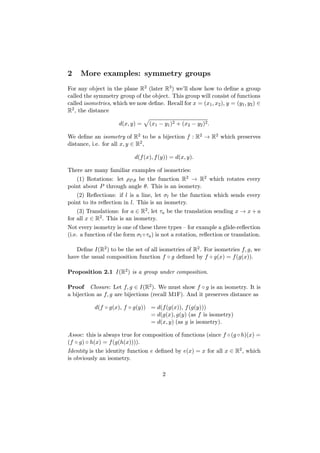

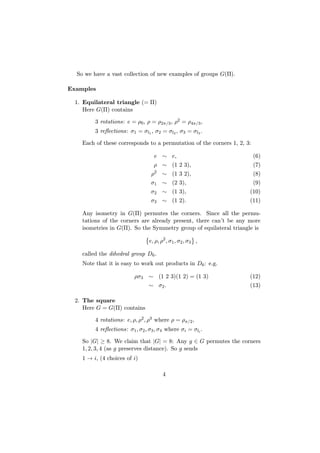




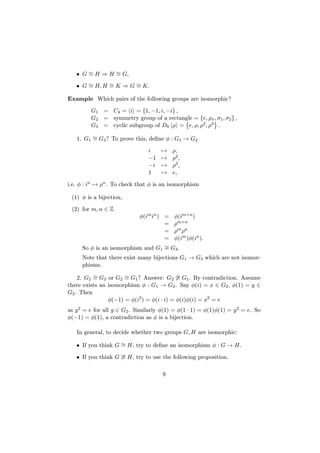

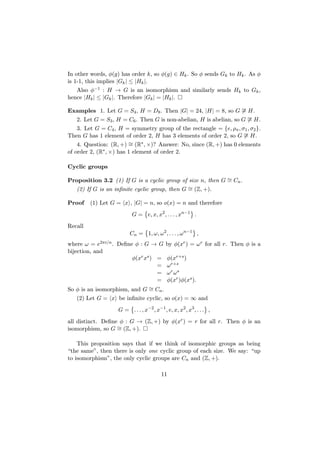
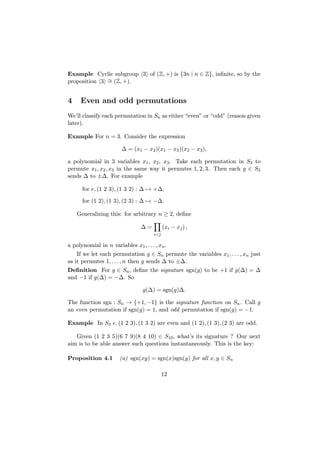



![3. A5:
cycle shape e (2) (3) (4) (5) (2, 2) (3, 2)
in A5? yes no yes no yes yes no
no. 1 20 24 15
Total |A5| = 60 = 1
2 5!.
5 Direct Products
So far, we’ve seen the following examples of finite groups: Cn, D2n, Sn, An.
We’ll get many more using the following construction.
Recall: if T1, T2, . . . , Tn are sets, the Cartesian product T1 ×T2 ×∙ ∙ ∙×Tn
is the set consisting of all n-tuples (t1, t2, . . . , tn) with ti ∈ Ti.
Now let G1, G2, . . . , Gn be groups. Form the Cartesian product G1 ×
G2 × ∙ ∙ ∙ × Gn and define multiplication on this set by
(x1, . . . , xn)(y1, . . . , yn) = (x1y1, . . . , xnyn)
for xi, yi ∈ Gi.
Definition Call G1 × ∙ ∙ ∙ × Gn the direct product of the groups G1, . . . , Gn.
Proposition 5.1 Under above defined multiplication, G1 × ∙ ∙ ∙ × Gn is a
group.
Proof
• Closure True by closure in each Gi.
• Associativity Using associativity in each Gi,
[(x1, . . . , xn)(y1, . . . , yn)] (z1, . . . , zn) = (x1y1, . . . , xnyn)(z1, . . . , zn)
= ((x1y1)z1, . . . , (xnyn)zn)
= (x1(y1z1), . . . , xn(ynzn))
= (x1, . . . , xn)(y1z1, . . . , ynzn)
= (x1, . . . , xn) [(y1, . . . , yn)(z1, . . . , zn)] .
• Identity is (e1, . . . , en), where ei is the identity of Gi.
• Inverse of (x1, . . . , xn) is (x−1
1 , . . . , x−1
n ).
16](https://image.slidesharecdn.com/grouptheorynotes-170210160717/85/Group-theory-notes-16-320.jpg)

![1. Since cyclic groups Cr are abelian, so are all direct products
Cr1 × Cr2 × ∙ ∙ ∙ × Crk
.
2. C4 × C2 and C2 × C2 × C2 are abelian of size 8. Are they isomorphic?
Claim: NO.
Proof Count the number of elements of order 2 :
In C4 × C2 these are (±1, ±1) except for (1, 1), so there are 3.
In C2 × C2 × C2, all the elements except e have order 2, so there
are 7.
So C4 × C2
∼= C2 × C2 × C2.
Proposition 5.3 If hcf(m, n) = 1, then Cm × Cn
∼= Cmn.
Proof Let Cm = α , Cn = β . So o(α) = m, o(β) = n. Consider
x = (α, β) ∈ Cm × Cn.
By 5.2(c), o(x) = lcm(m, n) = mn. Hence cyclic subgroup x of Cm × Cn
has size mn, so is whole of Cm × Cn. So Cm × Cn = x is cyclic and hence
Cm × Cn
∼= Cmn by 2.2.
Direct products are fundamental to the theory of abelian groups:
Theorem 5.4 Every finite abelian group is isomorphic to a direct product
of cyclic groups.
Won’t give a proof here. Reference: [Allenby, p. 254].
Examples
1. Abelian groups of size 6: by theorem 5.4, possibilities are C6, C3 × C2.
By 5.3, these are isomorphic, so there is only one abelian group of size
6 (up to isomorphism).
2. By 5.4, the abelian groups of size 8 are: C8, C4 × C2, C2 × C2 × C2.
Claim : No two of these are isomorphic.
Proof
Group C2 × C2 × C2 C4 × C2 C8
| {x | o(x) = 2} | 7 3 1
So up to isomorphism, there are 3 abelian groups of size 8.
18](https://image.slidesharecdn.com/grouptheorynotes-170210160717/85/Group-theory-notes-18-320.jpg)



